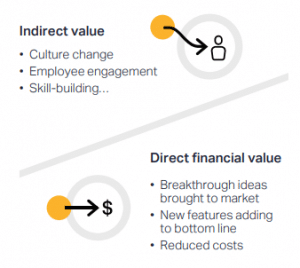Health care to high tech. Aerospace to automotive. Retailing to real estate. Energy to education. No matter what industry you operate in, you’re very likely impacted by disruption, whether it’s from new technologies, customer experiences, or even new business models. And you may be either mainly among the disrupted or the disruptors.
Whichever is the case, we are all increasingly aware of the benefits of crowdsourced innovation techniques provided by a growing number of suppliers. On a personal basis, if I want to develop new ideas then one of my techniques is to go somewhere and work in a different environment for a while. Businesses are increasingly finding their requirements for developing new ideas and breakthroughs come from asking different people for their ideas, and employ the collective intelligence of employees, partners, customers, and even the public at large: people with some related experience or knowledge and an enthusiasm to be involved, though outside the immediate corporate mindset that can homogenize thought processes.
Spigit is the most widely used idea management platform in the world, and the leading crowdsourced innovation management software supplier in the marketplace with over 6 million users in more than 170 countries. Key corporate customers include Pfizer, Citi, AT&T and Siemens. Their global HQ is in San Francisco, London is home to the European HQ and the Asia-Pacific HQ is in Sydney.
However, an ideation program on its own to discover ways to drive a business forward may often not be enough. Most of Spigit’s clients cite culture change as their single biggest goal when starting a crowdsourced ideation program, though even when it isn’t it remains a necessary element to attend to. After all, most people are change resistant, preferring to remain in a workplace comfort zone of known expectations with a proven historic acceptance by all parties of an input to reward function.
Once a change culture is established, numerous innovations that would deliver direct cost benefits can be researched.
Spigit has established beyond doubt that involving employees in organizational decision-making increases their engagement levels and the acceptance rate of innovations and developments. Through ultimately cultivating an overall recognition of the benefits of change, organizations can then make more rapid advances in the development of better products, services and operational methods. And this can be extended to external customers and partners as well.
The other side of the coin can be very expensive. Disengaged employees are costly. A recent Deloitte report notes that organizations spend over $100 billion annually to improve employee engagement. Despite that, 87 percent of employees remain disengaged and cost U.S. companies $450 billion to $550 billion per year in lost productivity, according to Gallup.
When it comes to the actual crowdsourcing of input and insight, whether from employees, partners or customers, Spigit helps organizations to scale their programs in a variety of ways with single issues broken down into a number of challenges, using multiple techniques and approaches, and engaging external as well as internal participants. Including employees whose roles may not be connected directly to the challenge can further kickstart an internal culture change, gaining valuable input that otherwise might have gone unheard and fostering a healthier attitude on buy-in to ensuing development and innovations. Spigit’s research discovered that 31% of its clients’ winning ideas have come come from a department outside the one that is running the challenge.
Spigit makes it easy to resolve both surface opportunities and deeper problems – from new product ideas to process improvements to customer experience improvements – through their provenly successful software combined with continually evolving technology, in-house expertise within a global best-in-class innovation strategy team, and their own data research.
You may think that the responsibility to run crowdsourcing projects lies just with a team that focuses on the “innovation” function. Among Spigit’s clients this is true in many instances, though in 56% of cases the crowdsourcing projects emerged from the functions that would be impacted by any resulting innovation.
Taking on crowdsourcing project responsibilities leads people across a wide range of functions from Strategy to Supply Chain to develop new skills and widens the innovation culture within an organization.
Successful implementation of good results is vital and is usually handed to someone else within the organization. In many instances the implementation goes to IT or Operational teams, though it doesn’t need to be. What is important is that somebody is named responsible before everyone returns to what’s on their formal job spec and momentum is lost.
And finally, while innovation is a creative process upfront, it is also a business discipline that must be managed and measured or it will not withstand the competitive pressure for support and resources. Soft metrics relating to engagement and collaboration – such as the number of crowdsourcing challenges run, number of active participants, total ideas submitted, number of votes and comments from the crowd and so on are excellent data to demonstrate success linked to culture change and employee engagement.
But people are going to want to know the hard facts of contribution to turnover and profit in both a direct and an indirect manner. Spigit will ensure that tracking mechanisms for measuring value are hard-baked in to the crowdsourcing projects from the start to enable innovation leaders to demonstrate success and business impact, and ensure sustained investment in their program.
What are your experiences of crowdsourcing innovation? Please share them with the Crowdsourcing Week community, we’d like to hear them.







0 Comments